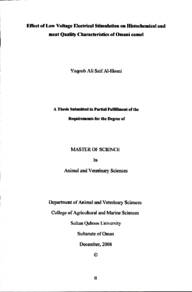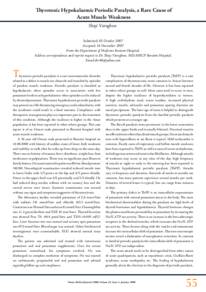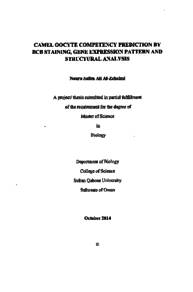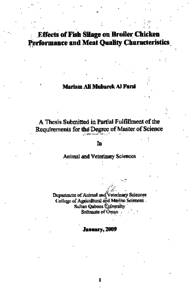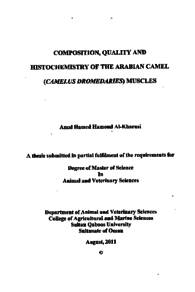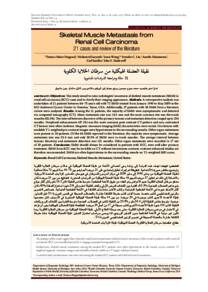وثيقة
Effect of low voltage electrical stimulation on meat quality characteristics of Omani camel
الناشر
Sultan Qaboos University
ميلادي
2008
اللغة
الأنجليزية
الملخص الإنجليزي
Two experiments were conducted to study the effect of low voltage electrical stimulation on histochemical, structural and meat quality characteristics of Omani camel carcasses. The first experiment was carried out to evaluate the effects of stimulation and ageing (2 vs. 7 days) on meat quality of four age groups of camel (1-3, 4-6, 7-9 and 10-12 years old). Warner-Bratzler shear force, pH, sarcomere length, myofibrillar fragmentation index, expressed juice, cooking loss and L*, a*, b* colour were measured in 72 camels. Age of camel and electrical stimulation had a significant effect on meat quality of Longissimus thoracis muscle. The histochemical staining properties of the myosin ATPase and succinate dehydrogenase stains were also evaluated. Electrical stimulation resulted in a significantly (P<0.05) more rapid muscle pH fall of muscle during the first 12 hr after slaughter. Muscles from electrically-stimulated carcasses had significantly (P<0.05) lower pH values, longer sarcomeres, lower shear force value and higher expressed juice than those from nonstimulated ones. Electrically-stimulated meat was significantly (P<0.05) lighter in colour than non-stimulated based on L* value. Muscles of 1-3 year camels had a significantly (P<0.05) lower shear force value, and pH, but longer sarcomere, and higher myofibrillar fragmentation index, expressed juice, and lightness color (L *) than those of the 10-12 years camels. The proportions of Type I, Type IIA and Type IIB in camel muscle were 25.0, 41.1 and 33.6%, respectively. Muscle samples from 1-3 year camels had significantly (P<0.05) higher Type 1 and lower Type IIB fibres compared to those from 10-12 year camel samples. These results indicated that age and electrical stimulation had a significant effect on camel meat quality.
The second experiment aimed to evaluate the effect of splitting carcasses and stimulation on histochemical, structure and meat quality characteristics of two age groups camels (1-2 vs. 8-10 year old). Thirty camels were randomly assigned to one of four treatments: non-stimulated and electrically-stimulated; unsplit carcasses and split carcasses. The split carcasses were longitudinally split along the vertebral column. A low voltage electrical stimulation was applied 20-30 min post-mortem. The Longissimus thoracis muscle pH, sarcomere length, myofibrillar fragmentation index, shear force, expressed juice, cooking loss and CIE L*, a*, b* colour values were measured. The histochemical staining properties of the myosin ATPase and succinate dehydrogenase stains were evaluated. Electrical stimulation resulted in a significantly (P<0.05) more rapid pH fall in muscle during the first 12 hrs postmortem. Muscles from stimulated samples had significantly (P<0.05) lower pH, longer sarcomere, lower shear values than those from non-stimulated ones. Myofibrillar fragmentation index and expressed juice were significantly (P<0.05) higher for stimulated than for non-stimulated samples. Meat from stimulated samples was significantly (P<0.05) lighter (L *) in colour than non-stimulated samples. There were no differences in muscle quality between split and unsplit carcasses. Muscles of 8-10 year old camels had significantly lower expressed juice, cooking loss, darker (L *) more red (a*), more yellow (b*) and higher pH and myofibrillar fragmentation index than those from 1-2 year old animals. This experiment indicated that electrical stimulation improves quality characteristics of meat from unsplit and split carcasses.
المجموعة
URL المصدر
الملخص العربي
تم إجراء تجربتين لدراسة تأثير التحفيز الكهربائي على تركيب الأنسجة وجودة اللحوم في ذبائح الإبل العمانية. أجريت التجربة الأولى على ۷۲ من ذبائح الجمل التقييم آثار التحفيز الكهربائي و التعتيق ( لمدة ۲ و۷ أيام) على جودة اللحوم في أربع فئات عمرية مختلفة (1-3 و 4-6 و 7-9 و 10-12 عاما). تم قياس طراوة اللحوم والأس الهيدروجيني للحم وطول السارکومیر و مؤشر الجزيئات الصغيرة للعضلة و عصارية اللحم وفقدان الماء أثناء الطبخ ولون اللحوم ( * ، * b* , a ). أشارت الدراسة إلى وجود اختلافات معنوية نتيجة تأثير العمر والتحفيز الكهربائي على جودة اللحوم. تم كذلك تقييم الخصائص الأنزيمية للأنسجة العضلية ( ATPase و succinate dehydrogenase). أدى التحفيز الكهربائي إلى زيادة معنوية ( 0. 05>P) لسرعة انخفاض الأس الهيدروجيني للعضلة خلال الى ۱۲ ساعة الأولى بعد الذبح . تميزت العضلات المحفزة كهربائيا عن الغير محفزة بانخفاض في الأس الهيدروجيني للحم و زيادة طول السارکومیر و زيادة طراوة و عصارية اللحوم ( 0.05>P). كانت هناك زيادة معنوية ( 0.05>P) في لون اللحوم المحفزة كهربائيا ( *L) عنها في اللحوم غير المحفزة. تميزت العضلات من الفئة العمرية ( ۱-۳ أعوام ) بارتفاع الطراوة وانخفاض الأس الهيدروجيني ( 0 . 05>P) مع زيادة في طول السارکومیر و ارتفاع مؤشر الجزيئات الصغيرة للعضلة وزيادة عصارية اللحوم واللون (*) مقارنة بما سجل في عضلات الفئة العمرية (۱۰-۱۲ عاما). كانت نسب الخلايا العضلية الحمراء (Type I ) و المتوسطة ( Type IIA) والبيضاء ( Type IIB) للجمال 0, 25 , 1-41و 33٫6 % على التوالي. عينات العضلات التي أخذت من الجمال الصغيرة (1-3 أعوام) سجلت اختلافات معنوية ( 0 . 05>P) باحتوائها على أعلى نسب من الخلايا العضلية الحمراء (Type I ) و أقل نسب من الخلايا العضلية البيضاء ( Type IIB) مقارنة للأعمار الكبيرة (۱۰- ۱۲ عاما).
هدفت التجربة الثانية إلى تقييم تأثير التحفيز الكهربائي وتقسيم الذبيحة بطول العمود الفقري إلى نصفين على تركيب الأنسجة وجودة اللحوم من فئتين عمريتين ( ۱-۲ عام مقابل 8-10 أعوام ) من ذبائح الإبل العمانية. تم توزیع ثلاثين من ذبائح الإبل عشوائيا على أربع معاملات بحثية : محفزة و غير محفزة كهربائيا وذبائح مقسمة وغير مقسمة. تم قطع الذبائح طوليا على طول العمود الفقري إلى نصفين. طبق التحفيز الكهربائي ذو الجهد المنخفض ( ۲۰-۳۰ دقيقة ) بعد الذبح. تم قياس طراوة اللحوم والأس الهيدروجيني للحم وطول السارکومیر ومؤشر الجزيئات الصغيرة للعضلة و عصارية اللحم وفقدان الماء أثناء الطبخ ولون اللحوم ( * ، * b * , a ). تم كذلك تقييم الخصائص الأنزيمية للأنسجة العضلية (ATPase و succinate dehydrogenase ). نتجت عن التحفيز الكهربائي زيادة معنوية ( 0.05>P) في معدل انخفاض الأس الهيدروجيني للعضلة خلال 12 الساعة الأولى بعد الذبح. تميزت العضلات المحفزة كهربائيا عن العضلات غير المحفزة كهربائيا بأن بها اختلافات معنوية ( 0.05>P) في انخفاض الأس الهيدروجيني و زيادة السارکومیر و انخفاض طراوة اللحوم عن العضلات غير المحفزة. سجل مؤشر الجزيئات الصغيرة للعضلة و عصارية اللحوم اختلافات معنوية ( 0 . 05>P) حيث أنها كانت الأعلى في العضلات المحفزة. ومن ناحية أخرى ، أظهرت النتائج عدم وجود اختلافات معنوية بين الذبائح المقسمة و غير المقسمة. سجلت العضلات التي تم أخذها من الجمال الكبيرة في العمر ( ۸- 10 أعوام ) معدل عصارية لحوم و فقدان ماء منخفضين معنويا مع ارتفاع معنوي في الأس الهيدروجيني وارتفاع مؤشر الجزيئات الصغيرة و لون أغمق (*L ) بشكل معنوي. أفادت التجربة بأن التحفيز الكهربائي نتج عنه تحسين في خصائص جودة اللحوم من الذبائح المقسمة و غير المقسمة طوليا.
هدفت التجربة الثانية إلى تقييم تأثير التحفيز الكهربائي وتقسيم الذبيحة بطول العمود الفقري إلى نصفين على تركيب الأنسجة وجودة اللحوم من فئتين عمريتين ( ۱-۲ عام مقابل 8-10 أعوام ) من ذبائح الإبل العمانية. تم توزیع ثلاثين من ذبائح الإبل عشوائيا على أربع معاملات بحثية : محفزة و غير محفزة كهربائيا وذبائح مقسمة وغير مقسمة. تم قطع الذبائح طوليا على طول العمود الفقري إلى نصفين. طبق التحفيز الكهربائي ذو الجهد المنخفض ( ۲۰-۳۰ دقيقة ) بعد الذبح. تم قياس طراوة اللحوم والأس الهيدروجيني للحم وطول السارکومیر ومؤشر الجزيئات الصغيرة للعضلة و عصارية اللحم وفقدان الماء أثناء الطبخ ولون اللحوم ( * ، * b * , a ). تم كذلك تقييم الخصائص الأنزيمية للأنسجة العضلية (ATPase و succinate dehydrogenase ). نتجت عن التحفيز الكهربائي زيادة معنوية ( 0.05>P) في معدل انخفاض الأس الهيدروجيني للعضلة خلال 12 الساعة الأولى بعد الذبح. تميزت العضلات المحفزة كهربائيا عن العضلات غير المحفزة كهربائيا بأن بها اختلافات معنوية ( 0.05>P) في انخفاض الأس الهيدروجيني و زيادة السارکومیر و انخفاض طراوة اللحوم عن العضلات غير المحفزة. سجل مؤشر الجزيئات الصغيرة للعضلة و عصارية اللحوم اختلافات معنوية ( 0 . 05>P) حيث أنها كانت الأعلى في العضلات المحفزة. ومن ناحية أخرى ، أظهرت النتائج عدم وجود اختلافات معنوية بين الذبائح المقسمة و غير المقسمة. سجلت العضلات التي تم أخذها من الجمال الكبيرة في العمر ( ۸- 10 أعوام ) معدل عصارية لحوم و فقدان ماء منخفضين معنويا مع ارتفاع معنوي في الأس الهيدروجيني وارتفاع مؤشر الجزيئات الصغيرة و لون أغمق (*L ) بشكل معنوي. أفادت التجربة بأن التحفيز الكهربائي نتج عنه تحسين في خصائص جودة اللحوم من الذبائح المقسمة و غير المقسمة طوليا.
قالب العنصر
الرسائل والأطروحات الجامعية

